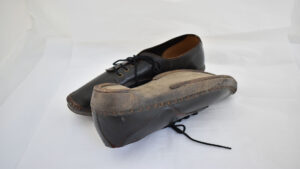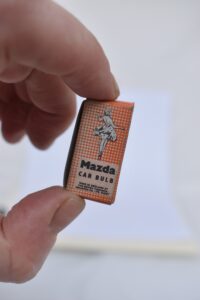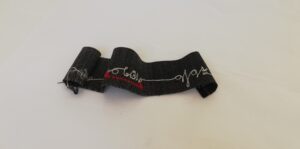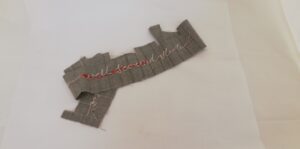Archive Assistant, Sunny Bank Mills



From the top, Workers clogs, Dashboard Bulb ‘Pin Up’ Packaging from 1950s, Ivy Barron machine-stitched free handwriting on cloth (C. 1950s/60s).
As Archive Assistant, my job on Saturdays is to provide weekend access for visitors to The Sunny Bank Mills Archive. To exchange and build knowledge and to help photograph, preserve and maintain the collection. I also contribute to the development of the Archive’s accessibility which includes working alongside our curator, Rachel Moaby towards building a fun, activity-orientated family-friendly tour intended to be put in place soon.
In the morning I set up and uncover the displays. There is always cleaning and checks to be undertaken by everyone throughout the week as part of the role of caring for a collection.
Once the computer is fired up, I can see if there are any advance bookings for that day. Also, same-day tour bookings will pop up on the screen on a Saturday morning as people start to wake up and plan for their day. I get excited when I see visitor numbers for the day knowing that it will be filled with rich conversation about the mill and its layered and varied histories.
It has been a privilege to meet with the people who have passed through the door since I began at the Mill. Some have generously contributed their personal and family stories. Some (such as students, artists, writers, and makers). take away new knowledge towards their own interests or projects Some visitors just like to have a chat. To reflect on what life was like for the different people who have lived in Farsley over the 200 + years of the Mill’s existence.
A tour will usually last 40 minutes, followed by time to wander and take in the collection and displays independently.
Each visit starts with an introduction or briefing to explain to people what we do in a Living Community Archive (how it differs from a museum as an active holding place of mostly unprocessed content). From this point, a tour can go in any direction depending on a group of visitors. I particularly like when I have a group with separate bookings. Or a mix of different people with different interests, age demographic, or nationalities.
I love the element of discovery that I experience each day that I come into the Archive. I might spend an afternoon photographing car dashboard bulbs from the 1950s in their original ‘pin-up girl’ packaging. Car dashboard bulbs are an example of the diversity of the collection and how, while every item included at Sunny Bank Mills Archive is related to Sunny Bank Mill, each item is not necessarily relevant to the Textile Industry alone. One single object, item, or mark around the Mill can lead to re-looking and mapping out historical routes.
It is difficult to choose just one story about the many lives that have been part of the history of this place. For example, I have developed an ongoing investigation of my own during my brief time as Archive Assistant. It is a growing story about a woman named Ivy Barron who lived in Farsley and was employed at Sunny Bank Mills in the mid-twentieth century. I have found samples of fabric with Ivy’s machine-stitched free handwriting indicating if a piece of cloth was “well scoured” and finished to Woodhouse Mill standards (Sunny Bank Mill was known as Woodhouse Mill after one of the early owners of the Mill, Edwin Woodhouse). I’d like to get to know more about Ivy but I am happy to take my time to unpick her unique story among many others.

Ivy Barron machine-stitched free handwriting on cloth (C. 1950s/60s).
If you have stories to share about the Mill or any information on Ivy Barron we would love to hear from you. Contact Sally at [email protected]
Back To Blog Next (Heritage Open Days 2022) Prev (The wonders of Tyvek®)
Tags
General Museum & Archive Arts & Culture
